The Roosevelt Palm: City of Riverside Landmark #64
Location: The corner of Victoria Avenue and Myrtle Avenue.
Date Established: 5/7/1903
Date Visited: 6/28/2014
One of the most celebrated pictures in Riverside is that of then President Theodore Roosevelt planting the original Navel orange trees at the Mission Inn on May 8, 1903.Unfortunately, that tree died in 1922 as a result of a bad fungus infection. The last known bit of that tree is currently in South Africa, a gift from Dr. Archibald Shamel to Sir Percy Fitzpatrick. A sad story but luckily the other orange tree at Magnolia and Arlington is still alive.
What very few people talk about in Riverside is that there is another tree in Riverside planted by President Roosevelt that is still alive. The centennial tree is a Mexican Fan Palm located on the corner of Victoria Avenue and Myrtle Avenue. The date was May 7, 1903 and the President was right in the middle of an ambitious campaign tour of the 25 western states.
Prior to arriving in Riverside President Roosevelt had already made speeches in Barstow, Victorville, and Redlands. Despite the very long day the President stopped his special campaign train at the Pechappa siding near Arlington Avenue, which was several miles away from downtown. By invitation of Cornelius Rumsey President Roosevelt went on a tour along Victoria Avenue, which at the time was the main corridor for the city of Riverside.
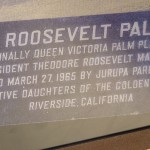
The Roosevelt Palm Plaque when it was first set up on 1965. (Note: The 5/8/03 date on the plaque is wrong)
It was on this scenic ride a memorial was laid by Mr. Rumsey that said the following:
“In remembrance of the constant friendship of Queen Victoria for the American Republic this memorial palm was started by Theodore Roosevelt, President of the United States of America. May 7, 1903, the gift of a son of the American Revolution of the sixth generation of American ancestry.”**
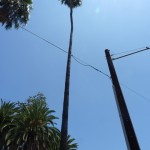
A view up of the Roosevelt Palm. Looking at the bark it looks like it may have sustained fire damage.
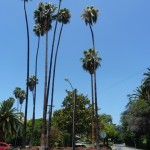
A view of the corner of Victoria Avenue and Myrtle Avenue. The Roosevelt Palm is the one on the far right.
After the very brief stop the procession continued on Victoria, across the Victoria Bridge (which was still made out of wood), and on to Glenwood (Mission Inn) Hotel at which he arrived very late. While there he gave some brief remarks:
“AT RIVERSIDE, CAL., MAY 7, 1903.
Mr. Mayor, and you, my fellow citizens:
I have enjoyed to the full getting into your beautiful State. I had read about what I should expect here in Southern California, but I had formed no idea of the fertility of your soil, the beauty of your scenery, or the wonderful manner in which the full advantage of that soil had been taken by man. Here I am in the pioneer community of irrigated fruit growing in California. In many other parts of the country I have had to preach irrigation. Here you practice it, and all I have to say here is that I earnestly wish that I could have many another community learn from you how you have handled your business. Not only has it been most useful, but it is astonishing to see how with the use you have combined beauty. You have made of this city and its surroundings a veritable little paradise.
It has been delightful to see you. Today has been my first day in California. I need hardly say that I have enjoyed it to the full. I am glad to be welcomed by all of you, but most of all by the men of the Grand Army, and after them by my own comrades of the National Guard, and I have been particularly pleased to pass between the rows of school children. I like your stock and I am glad it is not dying out.
I shall not try this evening to do more than say to you a word of thanks for your greeting to me. I admire your country, but I admire most of all the men and women of the country. It is a good thing to grow citrus fruits, but it is even a better thing to have the right kind of citizenship. I think you have been able to combine the very extraordinary material prosperity with that form of the higher life which must be built upon material prosperity if it is to amount to what it should in the long run.
I am glad to have seen you. I thank you for coming here to greet me. I wish you well at all times and in every way, and I bid you good luck and good night.”*
Keeping up the pace he planted the Tibbets tree at the Mission Inn early the next morning and went on to make additional speeches in Claremont, Pasadena, and Los Angeles on the same day.
The tree today (6/28/14) still stands, but not alone as it is accompanied by a few other palm trees on a little island at the side of the road. Originally the tree was called the Victoria Palm because many people living on Victoria Avenue were from England, but over time it was renamed the Roosevelt Palm after Theodore Roosevelt who planted the tree. The palm tree is very tall, but not the tallest of the group at the location. The bark kind of has a black coloration to it, which is odd for a palm tree. It kind of looked to me that the tree has survived fire or disease (maybe both).
Also at the side of the road is a little memorial garden called the Helen Hays Yeager Memorial Grove, which was built by the Victoria Avenue Forever Organization. Helen Hays Yeager was a Riverside local for 50 years and was known for taking care of the orange trees at that corner. After her death her husband dedicated the grove to the city of Riverside as garden and the Victoria Avenue Forever organization planted their signature ragged roses at the location. The park was officially dedicated on January 11,2011 and is open from 10am-2pm 7 days a week.***
*Theodore Roosevelt: “Address at Riverside, California,” May 7, 1903. Online by Gerhard Peters and John T. Woolley, The American Presidency Project. http://www.presidency.ucsb.edu/ws/?pid=97709.
**Patterson, Tom .”Landmarks of Riverside and the stories behind them”.Riverside, CA: Press-Enterprise, 1964.
***Smith, Jeff. “The Helen Hays Yeagar Memorial Grove.” Victoria Avenews 21 (Jan. 2013): 1. Print.


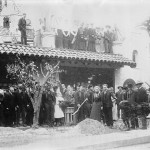
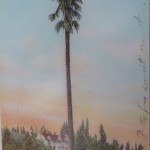
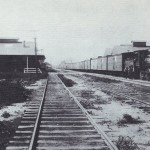
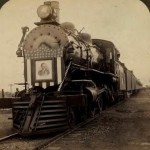
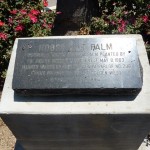
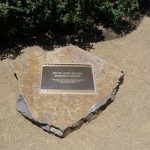
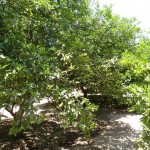
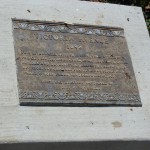
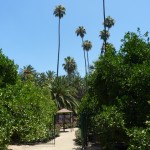
I always wonder how old those super tall palms are. Amazing that they can survive on such a long thin trunk.
Gooday I’m in front of a Roosevelt type home here in Avalon Catalina… Do you know or does anybody know how tall these palms get do they break do they actually just grow twice as tall inquiring mind wants to know and thank you for your efforts.
The Roosevelt Palm is a Mexican Fan Palm, but they call it the Roosevelt Palm because President Roosevelt planted the tree himself after touring Victoria Avenue.
The palm isn’t going to eventually break off.
I agree, these type of Palm Trees will grow for hundreds of years until disease gets them.